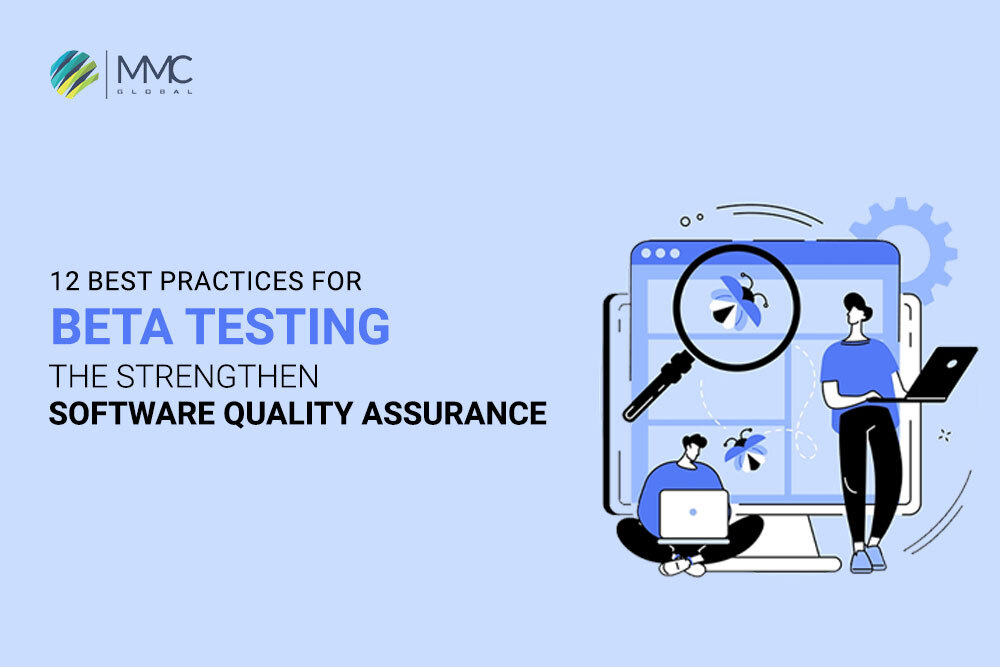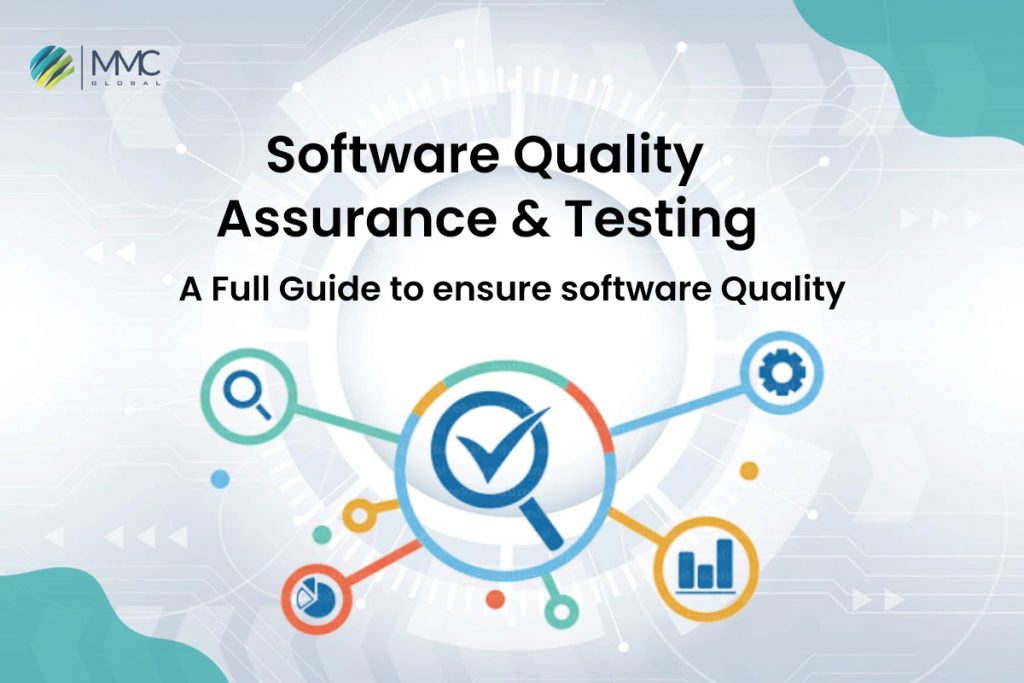What Are The Key Methodologies For Software Quality Assurance & Testing? A Comprehensive Guide 2022
Writing code, integrating APIs, and building a strong database is not enough for software development. But ensuring your software quality is the biggest achievement for developers. Software and apps must be tested carefully to create high-performance and impactful software or application for your clients.
As in our company, MMCGBL, we are very concerned about software quality & adequate testing. That’s why we have employed a huge number of software quality assurance team that assists us in provoking flawless mobile applications and software per our client’s requirements.
Moreover, we provide every type of software quality assurance service; that’s why we gather thousands of third-party projects just to ensure the quality of their developed software. Our Software quality assurance team identifies setbacks, creates documentation, and makes sure to fix all the errors and bugs before handover to the client.
Examining the software or application contains multiple stages and methodologies that every software tester has to cover. Likewise, we do in MMCGBL. If you are interested in knowing the key steps and practices our testers are following, you can contact us for consultation and hand over your project to conduct a full app or software analysis and examination before launching your product.
For the time being, go through this article, it will guide you on the methodologies, types, and testing automation frameworks we can use according to your project needs.
Tip: before hiring any outsourced software quality assurance services, this is the plus point if you are familiar with testing terminologies, methods, and approaches.
Let’s dive straight and get to know what you need to know!
Key Methodologies For Software Testing
Let’s be clear about software testing methodologies and types; they are both different and much needed to sort out here. You can experience various testing methodologies which depict how testing can proceed concerning project management.
On the other hand, multiple quality assurance testing types are conducted throughout the development process. Testers will pick it as per the technical side of the testing process.
To know more about multiple types of software testing services, just read this blog: Software Quality Assurance & Testing – Process, Techniques, And Types.
Agile Methodology
It is the most streamlined software quality assurance testing methodology since it helps testers conduct testing thoroughly. The agile method consists of short assessments and is split into groups of tasks called “sprints.”
Each sprint consists of a small task related to software testing; you can sort out your sprint with an agile testing life cycle, such as:
- Planning sprint task
- Designing test cases
- Quality verification and validation
- Review product stability
- Regression and deployment
The agile methodology ensures not skip a single corner of the software or app. As soon as the tester tests a portion of the app, called unit testing, and finds a bug, they will ultimately inform the development team to fix it.
After fixing, the tester will know which part should be retested as it had ambiguity previously. Another working method you might hear about is Scrum. The Agile approach includes Scrum, which is likewise based on sprints.
Every scrum sprint concludes with a review meeting where the software quality assurance team discusses progress and plans for subsequent software testing sprints.
Waterfall Methodology
Waterfall methodology is another software quality assurance and testing approach in which the tester performs step-by-step software testing. The software quality assurance team will not proceed next step if the previous one is not sorted out.
If you are testing functionality that is not working properly, then you have to wait to fix it by the development team to. Once the development team completes the fixes, you must retest and go further for the next planning step.
The requirements phase, which comes first in the waterfall methodology, is when all project needs are fully determined before software testing begins. The software quality assurance team creates a thorough test plan at this phase after discussing the testing’s scope and approach.
The team won’t begin running test cases to ensure the generated software functions as intended until the software design is finished.
The drawback of the structured software testing methodology is that it prevents the team from quickly making changes.
V Model or Verification and Validation Methodology
It is one of the productive software quality assurance methodologies as it saves time and makes rapid fixes along with the development process.
V model assists the development process by testing core functionality parallel: while the development is ongoing, the SQA team tests the functionalities side by side. When a given stage of development is complete, the team starts testing a completed component of the product right away. The software quality assurance team may modify the product early on using this method, which will ultimately reduce time and money.
Incremental Methodology
There are several iterations involved in the incremental testing process. Each of these cycles consists of many components. Every iteration improves the product by introducing additional practical features.
Typically, this paradigm’s design and development, testing, and final implementation phases are broken into three steps.
The key benefit of this approach is how adaptable it is, allowing a testing team to swiftly make changes to the testing procedure.
Spiral Methodology
This software quality assurance methodology may be regarded as a component of incremental software testing.
It also includes cycles that build on top of one another. The four steps are planning, risk analysis, engineering, and final assessment.
When a cycle finishes, the next one starts. Additionally, teams receive quick test feedback following the last phase of each process, ensuring that the product’s quality is good.
With the help of this approach, testing teams may easily identify mistakes and, more importantly, their root causes.
Extreme Programming Methodology
The extreme programming (XP) methodology is based on the collaboration between two team members in which one can play with the code, and the other can test hand to hand.
It can reduce time, make development faster, and effectively show results. Once a piece of code has been developed and tested, each stage of this test process may be deemed finished.
Teams may produce high-quality code using this method since each line is meticulously examined.
Customer Validation Methodologies – Alpha Testing & Beta Testing
Including the acceptance of the in-house team and the client side is necessary. Both teams have to come to one table that enhances the confidence of launching your product in the market.
To know the perception of customer over your product, the SQA team conduct Alpha testing and Beta testing. These methodologies contain the same testing methods and have the same types of software testing, but the strategy is different.
What is Alpha Testing?
The first step in determining if a new product will function as anticipated is alpha testing. Internal staff conducts early-stage alpha tests before moving on to beta tests, which involve a representative sample of the target market using the product.
What is Beta Testing?
Beta testing is conducted when the product is fully completed and ready to launch but for a specific and small group of users. However, they are the actual users but smaller than the expected users. However, it is not the final launch.
The selected number of people for beta testing examines the product, gives feedback, and supports you in making a more optimized product or any required changes. In a nutshell, beta testing is when actual users test a product in a real setting.
Do We Need To Conduct Mobile Application Testing?
Of course, yes! The mobile app is a giant player in the software development industry, as many mobile app development companies are building robust apps as per businesses’ requirements. The mobile application development process is the same as software development: planning, designing, developing, testing, and implementing.
When the SQA team tests the mobile app, they ensure mobile usability for the end-users. A few essentials cannot be ignored because those elements ensure the application’s quality, called mobile usability testing.
Note: Don’t confuse software and applications. Every application is software but not every application is software—the term “software” refers to all types of computer data. Applications are a subset of software that carry out certain tasks.
It entails evaluating various aspects, including the user interface, performance, functionality, and more. Here is a list of factors that make it essential to do a mobile app usability test before making it available for download to the general public and improving user experiences.
- Identify the design challenges.
- Look for ways to improve the design
- Recognize your user preferences and behavior
- Reduce the total cost and duration of troubleshooting
- Ensure a pleasant user experience
Moreover, there are many mobile usability methods every SQA tester should know:
- Phone Interview
- Guerilla usability testing
- Contextual Inquiry
- Eye-tracking Test
- Card Sorting
- 5 Second Test
- Moderated usability testing
- Unmoderated Usability Testing
- Lab Usability Testing
- Screen Recording Test
Also Read: Why is Software Quality Assurance vital for your business?
3 Important Mistakes to Prevent in Your QA Testing Process
It would help if you avoided a few things while testing; you will see the ultimate effectiveness of software quality assurance.
Not specifying the testing scope
Defining the scope of what you are doing is significant. SQA is the most responsible job because the base of customer satisfaction depends on the SQA team. If you skip the error or any bug, your testing will not be fruitful, badly impacting the whole user experience.
As a tester, you must be aware of all types of tests, methodologies, and other trendy approaches that make your testing meaningful. All multiple aspects should be considered while testing whether to focus on the codebase or functionalities.
Even if you have lots of time, you will certainly need to prioritize particular tasks over others. As an illustration, code quality is a crucial topic. Additionally, you want to watch out not to forget about things like regression testing. A new feature could bring flaws and endanger already-existing functionalities.
Inadequate documentation
Proper documentation is the key to successful testing and a result of software quality assurance. You have to jot things down adequately to record your development team’s initial to last stage progress.
Keeping track of progress on particular activities is also crucial. When there is a dearth of documentation in this area, QA teams frequently work inefficiently or even forget or missed to complete tasks. In extreme cases, it may result in functions being tested repeatedly for no apparent reason and certain features being left incomplete or broken. If you get software quality assurance services from a third party, they provide fully managed documentation at the completion of their task.
Using tool inefficiently
Although there are two ways to start software testing, i.e., automated or manual, you can choose one or both. The effective use of automated testing leads you excellent software quality and also reduces the time of doing things.
It is up to the tester how efficiently they test, find bugs or errors, and send them back to the development team. As soon as they send them, developers resolve the issues. But to make all these things happen, you must know the use of tools in the market.
You must be familiar with all types of software quality assurance and testing tools. But before purchasing tools, ensure they will help you throughout the testing process while keeping your budget in mind.
Although automating testing save time, it is good to consider manual testing. Please don’t rely on automation fully and balance the use of manual and automated to get the optimum results.
Learn more: What are the Goals, Attributes, and Metrics of SQA Testing?
So, Are You Ready To Test Your Software Quality?
I hope all the vague now clear about testing and software quality assurance; now is the time that you can start testing your product effectively.
The effective results will become when you have professional software quality assurance & testing team members in your organization. One other cost-effective option is outsourcing. Making your work review with a third party will help you with honest feedback at every step.
Moreover, if you do not want to invest in making documentation, or purchasing tools, you must look for someone who can help you with some hacks. Most software quality assurance companies have comprehensive testing tools and experts who can perform testing manually and technically and give you real-time feedback to improve your product. Rather than building your team, it is good to invest in it for temporary usage.
FAQs Related to Software Quality Assurance & Testing Services
What is the difference between software quality assurance (SQA) and tetsting?
The process of ensuring that your product is of the highest quality and touches the specific set of standards for your clients is known as quality assurance (QA) testing. On the other hand, testing is the method to check software work properly and enables us to ensure software quality by strictly reviewing the codebase, functionalities, and features.
What is regression testing?
Regression testing refers to the retesting of software functionalities or codebases to ensure the bugs or errors are fixed after modifications or changes are made.
Who made test cases?
Your SQA team is responsible for making test cases, managing documents, and report you when they are done with testing. If you outsource your product for QA, they handle all this.



